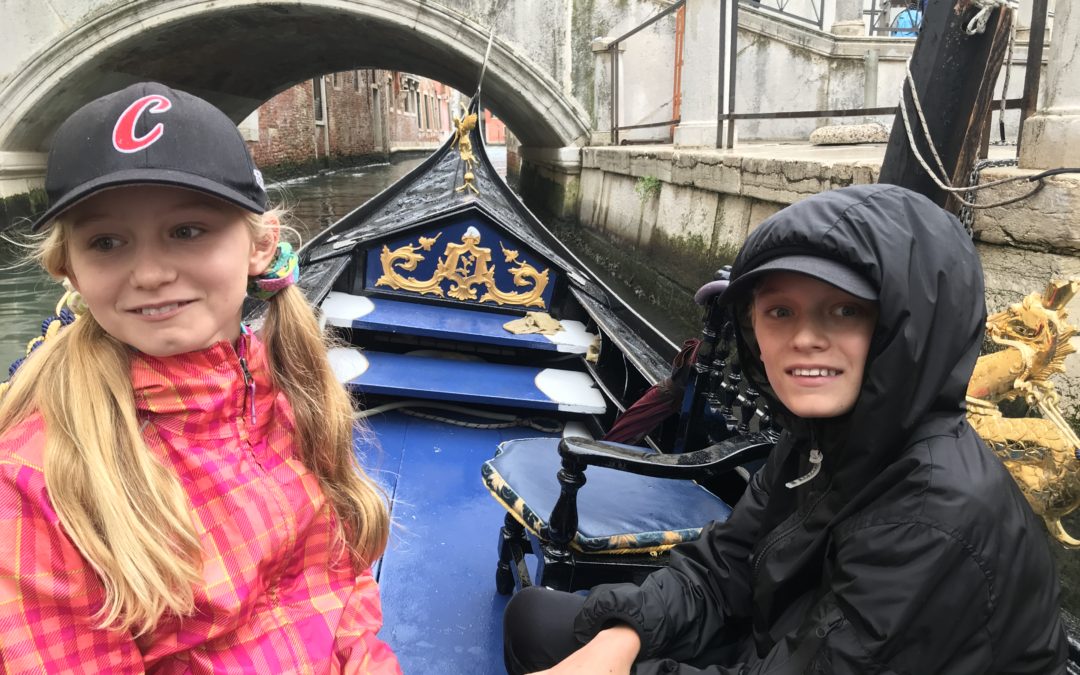
Sep 25, 2019
We had a busy final few days in Bologna.
I watched the last two days of the European/Africa qualifiers… which ended in disappointment for the Italian hosts, when their team dropped a one-run game to Spain (followed by a bench-clearing brawl) and then lost a final must-win game against the Netherlands (giving up 4 runs in the top of the 9th to put any hope out of reach), who placed second and kept their Olympic dreams alive.
Team Israel walked away with first place and the berth in Tokyo, losing only a single match (to the Czech Republic) along the way. Alas, I didn’t see them clinch, as they did it on the last day in Parma.
On Monday, after the tournament, we took a high-speed morning train to Venice — where the clouds emptied in a downpour onto the thousands of tourists in cheap ponchos. We still enjoyed 8 hours of wandering through the lagoon-bound city. Briar insisted that we take a gondola ride, which did not disappoint, as we drifted through a labyrinth of narrow canal-ways. Jenny got us to take a tour (out of the rain) of the Doge’s Palace in St Mark’s Square, which was fascinating in its ornate design and complex political history. (It also hosted a gallery show about Rubens and his contemporaries.) The armoury of weapons was especially impressive.
Looking for a free washroom (hard to find in Venice!), we stumbled across an exposition as part of the Venice Biennele, hosted by three African nations, which included several floors of contemporary art works.
Our favourite part of the day may have been wandering the old Jewish ghetto and surrounding neighbourhood, away from the crowds that were lured toward St. Mark’s Square. Here, we could imagine life in the this moody, water-bound ancient city.
The next afternoon, we picked up a rental car in Bologna and drove the toll highway past Florence, through multiple tunnels, to Montevarchi, where we headed up winding hillside switchbacks to our country “barn” AirBnB near Montegonzi… a town that none of the Italians we mentioned it to had every heard of!
After the heat of Rome and Florence, the weather is now autumnal and cool — we had a brief dip in the outdoor pool when we arrived — but not rainy. The surrounding hills are green and lush. Francesco, our host, is a fireman with a one-year-old baby who also runs the olive orchard (and gave us a bottle of his olive oil). He says that the harvest usually takes place at the end of October, but he might begin earlier, as the forecast is for a colder, wetter winter in these hills, on the edge of Chianti and Tuscany. His menagerie includes three dogs and two cats, which has delighted the kids.
We plan to just chill out and catch up on rest and “homework” and perhaps do a hike or two during our five-day stay here.

Sep 21, 2019
Bologna is the “business” part of our trip — 5 days of baseball, for a potential article or book about the the internationalization of the sport.
The World Baseball Softball Confederation have organized the Europe/Africa Olympic qualifiers, split between stadiums in Bologna and Parma, here in Italy. Six teams qualified, five from Europe (Italy, Netherlands, Spain, the Czech Republic, and Israel) and one from Africa (South Africa, who I’d seen decisively clinch their berth at the African Championships in May).
This tournament is a round robin with no playoffs. The top team will earn one of only 6 spots at the Tokyo Games next July. The second place team will hang on for a chance at a final play-in berth next spring… although likely against very good squads from the Americas and Asia. The other four will have their Olympic dreams end.
I’d gambled staying in Bologna. Unfortunately, more of the games (and more that I’d like to see) are in Parma, which is only 30 minutes by fast train but tough to get to and back again for games that begin at 8pm and the last train that leaves at 11:30pm.
So while I wanted to see Italy play South Africa on Wednesday night in Parma, instead I attended Spain vs. Israel here in Bologna. It turned out well. The Parma game got rain delayed with it tied 4-4 in the 5th and then moved to Friday morning for completion. The rains held off here in Bologna, and Israel — with a roster of American-born players, many rushed into citizenship before the European championships a few weeks ago — won a pitcher’s duel with a 3-0 win. Danny Valencia (former Blue Jay) led the way with a 2-run homer and a sac fly.
The next day, we all attended the afternoon (1:30pm) game between South Africa and Spain. Another tight pitcher’s duel got blown open with a 5-run fifth inning by Spain. who won 7-1. I returned alone for the evening game, with Italy facing the Czech Republic. The stands were closer to half full, after the sparsely populated earlier games I’d watched. The Czechs scored first, but Italy quickly tied it 1-1 with a Chris Colabello (another former Blue Jay!) hitting a sac fly. He added 3 more runs with a homer in the third and Italy cruised to a 5-1 win. More shocking, in the other night game in Parma, Israel scored 6 quick runs and beat the top-ranked Dutch 8-1 to upset predictions of who would earn the berth in Tokyo.
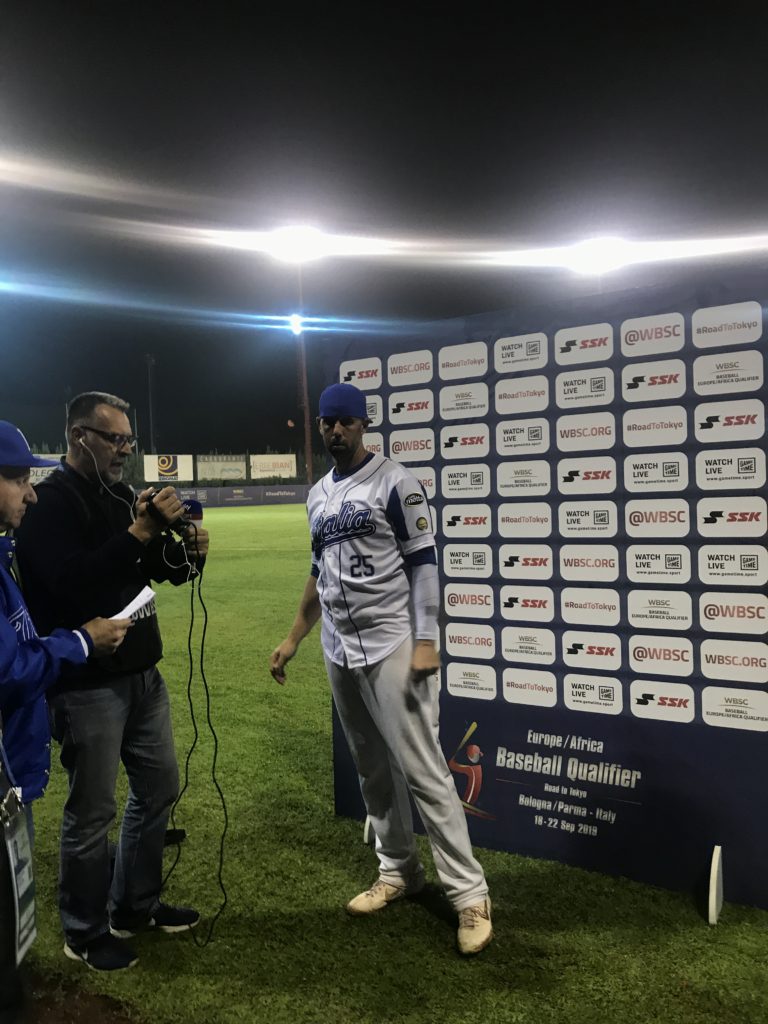
Chris Colabello after Italy’s win over the Czech Republic
The next day, alas, the big games were in Parma, so we did a sojourn into the old city of Bologna (to visit a zoological and anthropological museum and buy AJ the rain jacket he forgot to pack!) and then I watched the erratic live streams of the key matches back at our suburban apartment in Bologna.
Italy won the rain-delayed game (starting at 11am) in weird fashion, scoring 6 runs in the top of the 10th inning (world baseball rules put runners on 1st and 2nd base in extra innings, but 6 runs is still a lot!) and then ending the game in the bottom of the inning with a dubious triple play (off the first batter!) when Rowan Ebersohn fouled a pitch off home plate that appeared to then hit his leg and roll into fair territory. The umpire didn’t see the ball hit his leg, the Italian catcher threw to third, who threw to second, who threw to first, and a video review was disallowed (you can’t review fair/foul calls) so the missed call stood. Game over.
That set up the biggest game of the tournament so far: Italy vs. Israel in Parma in a battle of undefeated teams. The winner would control their destiny. Israel flirted with danger, as Italy kept putting runners on base early. But Italy left 10 runners on base over the nine innings and had their hopes fall to pieces in the top of the 8th, after Chris Colabello got beaned and had to leave the game in the bottom of 7.
The dominant Italian pitcher Luis Lugo was removed after beaning the first Israeli batter (perhaps in retaliation), and then Pat Venditte (famed ambidextrous former major leaguer!) struggled to shut down the inning and had to be removed. A squeeze bunt muffed by Colabello’s replacement at first base gave Israel a 3-2 lead. Another muff by the shortstop loaded the bases. And then three straight singles by Israel added 5 more runs.
Italian fans were stunned. And the Italian team could muster nothing in their final two innings. Team Israel had taken control of the tournament and only needs to win one of its games versus the Czech Republic or South Africa (both lower ranked teams) to secure their ticket to Tokyo. The final game in Bologna, with Italy versus Netherlands, had promised to be the big match. Now it looks like it might be the playoff for second place and a last shot at the Olympics.
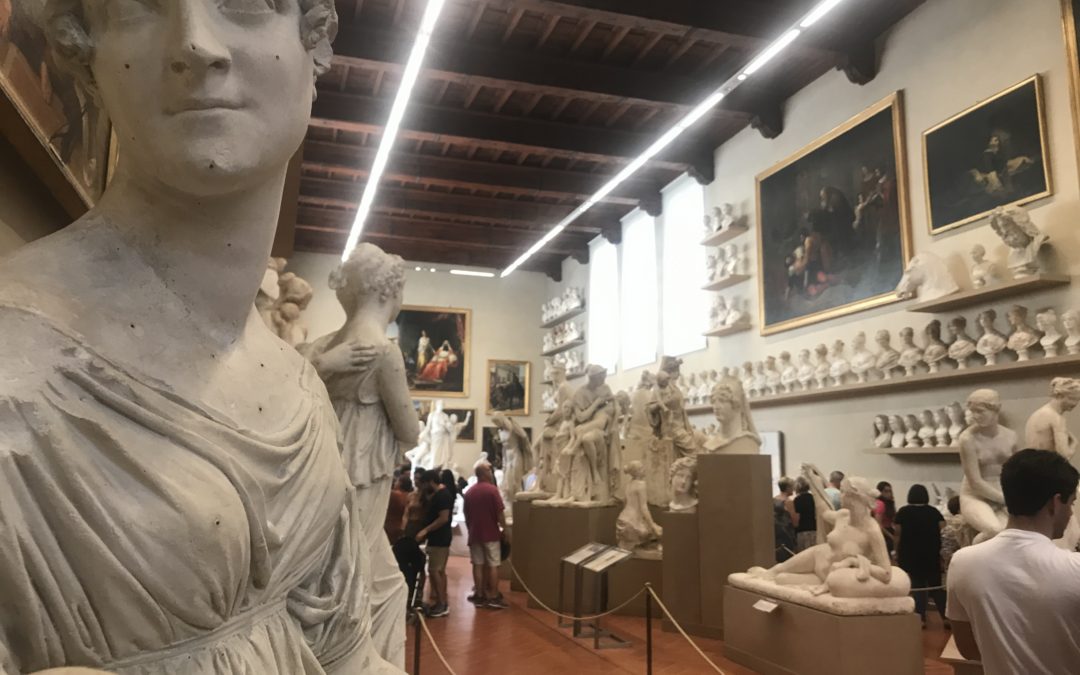
Sep 17, 2019
The joys of Florence!
A busy few days — and very slow wifi — have kept us all from blogging. On Saturday morning, we left Rome and caught a 11:45am high-speed train to Florence, the landscapes of central Italy zipping past at us at 250 km/h, to arrive in the city’s main train terminal an hour and a half later.
We had to drag our small suitcases across the cobbled streets and sidewalks and over a bridge to our next AirBnB, where we were met by Giulia, a hospitable local woman who had renovated the apartment for rent with her family. It was down a side street, a few minutes from the main tourist areas, and a delightful mix of funky (exposed brick, wooden ceilings set off by splashes of colour throughout) and functional (making good use of a submarine-like space that might have otherwise felt claustrophobic).
We were mere steps from anything we needed — and many things we didn’t know we required… like the first evening, when music and revelry drifted through our open window, so Briar and I went out to discover a jazz festival concert in the neighbouring square.
The next morning, we got up early (for us!) to make use of the 9am reservation at the Uffizi Gallery. AJ wasn’t feeling well — perhaps undone by the air pollution in Rome and a sleepless night in the new bunkbed — so he stayed back to sleep in.
Briar, Jenny and I wandered with a few thousand other tourists the art-packed rooms of Italy’s most famous art gallery. The highlights were the Botticellis, including his mega-famous Primavera, although we had more space to admire the rows and rows of ancient statues collected there. The gallery included the only complete oil-on-canvas work by Michelangelo as well as a fascinating illustrative progression from the flat, heavily symbolic, and deeply religious medieval works to the humane, complexly perspectived and vividly alive Renaissance paintings that defined the Florentine style. Briar soon ran out of energy, so we finished up in just under two hours and wandered back over the bridge to check in on AJ.

Primavera
He was revived enough to join us for an afternoon visit to the Accademia — a gallery more or less devoted to one work: Michelangelo’s David. And worth every minute there (even with the crowds). The “aura” of David, as you enter the hall and see him/it from a distance for the first time, can’t be diminished by the endless images and reproductions we’ve all seen over the years, the cartoons and cameos. The sense of awe grows even more as you approach and look up at his confident gaze and casual, yet ready pose. Selfies were being taken furiously around him, but he took no notice. He had a more important task at hand. (Full disclosure: I made sure to get a pic with my namesake.)
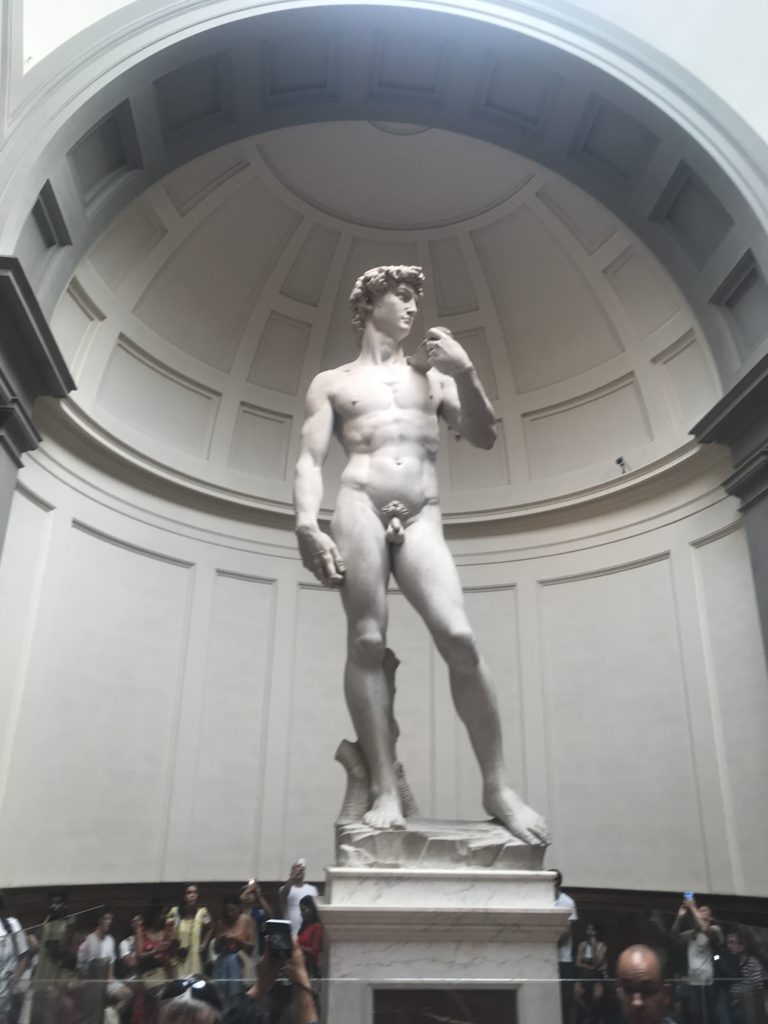
After leaving the gallery, we walked through the throngs of tourists in downtown Florence. Past the Duomo, through the Gucci shop (Briar’s request), over the Ponte Vecchio Bridge, past the Pitti Palace (where we would traipse through the Boboli Gardens the next morning), past more churches than we could count and enough gelaterias to set our appetites alight… and back to the quiet sanctuary of our mini-apartment in the delightful Oltrarno neighbourhood.
Our final day, we slept in till 11am. No galleries booked, to the kids delight. We let AJ and Briar choose our destinations. Briar led us to the Boboli Gardens… although was disappointed to learn it was the site of a maze… past tense. Then we walked along the Arno to a park with an outdoor pool, bought our tickets and our mandatory swimming caps, and enjoyed a cool dip and some lengths in the 30C afternoon heat. Finally, we capped it off with a meal — ordered entirely in Italian! — at the La Casalinga trattoria, famous for years among locals for its traditional fare.
And, yes, the pasta is on a whole different plane of pleasure here in Italy! And so is the gelato…
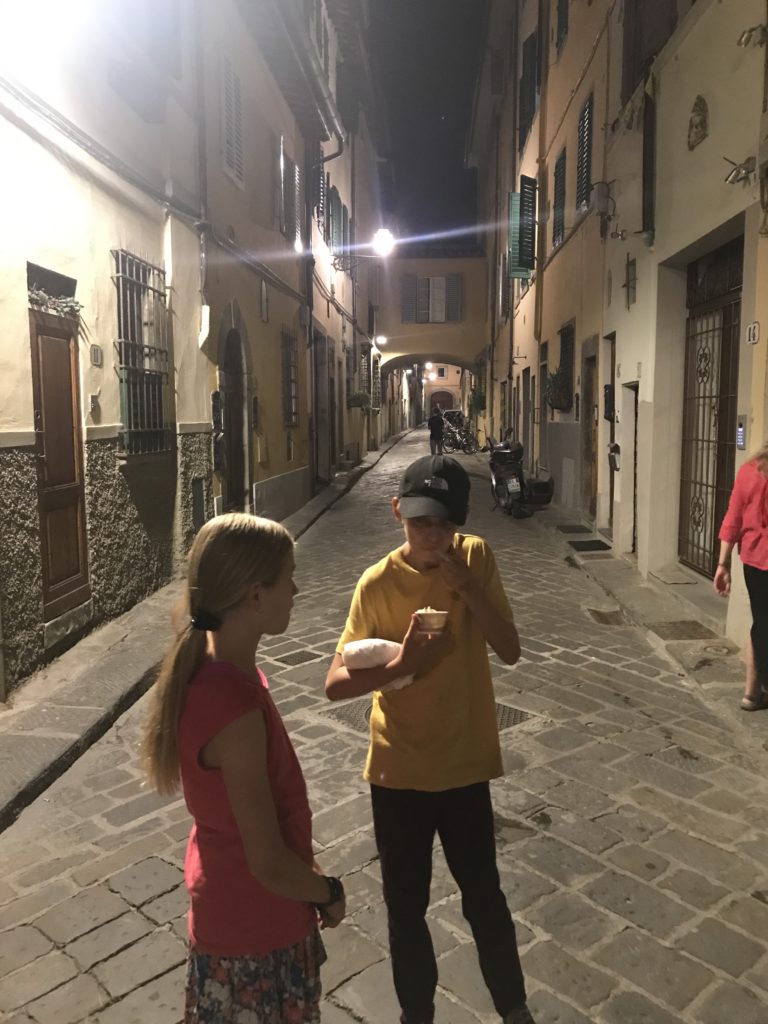
Sep 14, 2019
A trip to Vatican City
Our last day in Rome started slowly as we slept in (sort of — not all of us slept) with plans (and tickets) to visit Vatican City, to see St. Peter’s Basilica, the Museums and especially the Sistine Chapel.
First, we stretched our bared legs — we knew we couldn’t wear shorts to the Vatican City — with a walk past the Trevi Fountain, the Spanish Steps, Independence Square, and some of the area’s high-end shops. Briar wanted to check out the Gucci store but we needed to get back to our apartment.
A quick change and then we caught a bus across the Tiber River to Vatican City, where we lined up for access to St Peter’s Basilica, the largest church in the world. Technically, we were in another nation, one of the smallest in the world, although the colourful Swiss guards seemed to be the only giveaway. No passport required.
The kids were skeptical of checking out churches, but the scale of St. Peter’s left them awed—or at least minimized complaining for a while. A service of some sort was taking place and we watched as a procession of priests led congregants through a sfumato of incense, down the huge central nave, and into a smaller side chapel.
We admired Michelangelo’s Pieta and I helped a small Italian grandmother get a shot of the famous sculpture by holding her phone high above my head for an unobscured image. As we left the church, the Swiss Guard were performing their 6:00pm change with steely-eyed ritual… so we joined the observing throng.
Then we had a 7pm date with the Vatican Galleries, as I’d lucked in and discovered they were open in the evening, only on Fridays, which made it one of the least busy times to visit… which turned out to be true. We were in the first wave to enter and had several of the gallery rooms (such as the Egyptian wing) to ourselves, or joined by only a handful of other visitors, before the larger tour groups starting sweeping down the long galleries.
Highlights included the Belvedere Apollo; a mammoth bowl of porphyry for a Roman emperor (Nero?); the tapestry gallery (with huge depictions of the life of Christ, almost in the style of a contemporary graphic novel), and the map room covering every region of Italy. Then of course there were Raphael’s wall-sized and detailed depictions of papal and church history.
We didn’t do justice to the later and contemporary galleries that were in the way of the rush to see the Sistine Chapel, although I spotted a Chagall and a Francis Bacon down a wide wall as the kids demanded we keep up a good pace.
Finally, the security guards told people to put their cameras away as we entered the Sistine Chapel—and every head swivelled up to its famous ceiling. It didn’t disappoint. I felt dizzied as blood rushed between my ears and my eyes leaped from one famous image to the next, each an explosion of colour (now that the original paintwork has been restored from years of candle smoke) and dramatically frozen action. We sat along the edges of the chapel and tried to take it all in… sore feet and all.
And then the kids’ stomachs started growling and their patience had thinned and it was time to catch the Metro home for a late dinner and plans to wake early enough to pack up for Florence the next morning. But it will likely be an experience that none of us will forget any time soon.
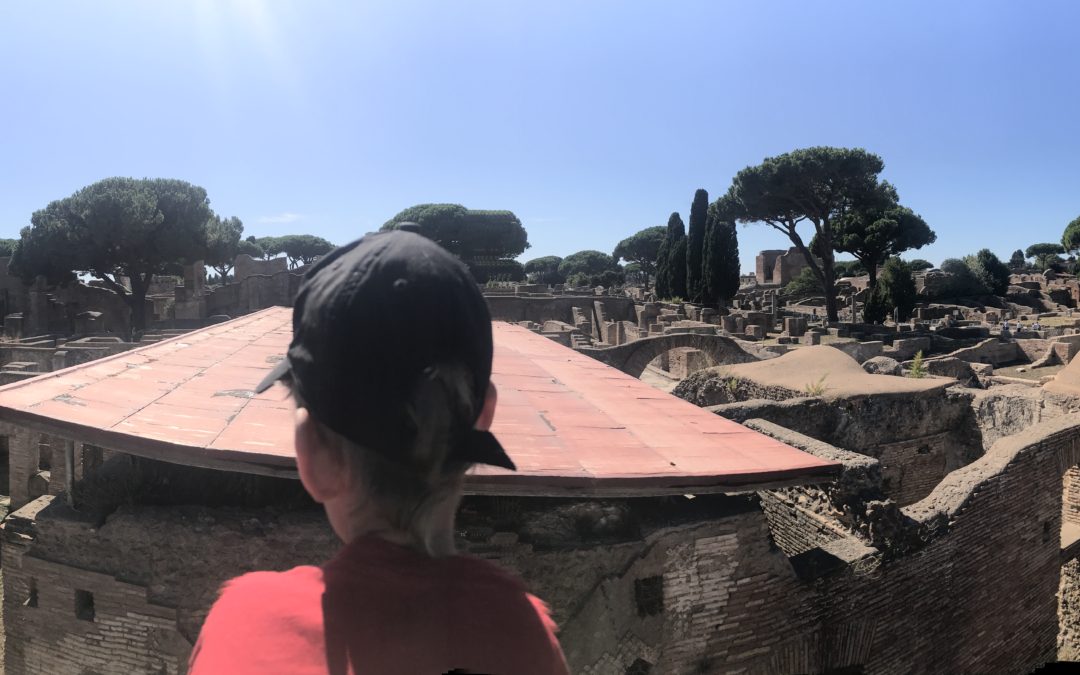
Sep 13, 2019
Ostia Antica
We got moving slowly on day 2 in Rome, only leaving the apartment after noon, after a restless sleep for just about everyone, nudging a little closer to re-aligning our sleep cycles.
The plan: a day trip out of the city to the Romain ruins of Ostia Antica and then our first tip in the Mediterranean in the seaside town of Ostia. We walked to the Metro, took it 3 stops, and then changed to a commuter train that led us beyond the city limits, in the direction of the airport, with a stop at Ostia Antica. A short walk led to the gates of the archaeological site — which will likely remain one of the highlights of our trip.
After the tourist smush at all the various highlights of Rome yesterday, Ostia Antica felt like a world apart. The site itself is large — a full town, in various states of restoration — and there were no crowds, just a few couples and small groups wandering the grounds in relative quiet. There was time and space to let your imagination wander back through the centuries to when this town — the first Roman colony outside of the city — was a vital naval base and then supply line to feed and clothe the million residents down the Tiber River in Rome.
We entered through the necropolis, through Ostia’s main gates, past the remains of warehouses that once housed grain and other supplies drawn from across the Mediterranean. Statues lined the cobbled road, including winged Minerva. A bathhouse floor was being restored — beautiful telework of Neptune, Neptune’s wife, the sea create Charybdis. We explored the amphitheatre, whited backed onto a U-shaped area for merchants: each of their stalls was advertised using telework: ships, urns, elephants to signify the ivory trade.

Restoring the bathhouse
Then we wandered off the main street into the narrower residential areas. You could feel the life of this ancient city in the texture of the walls, the labyrinthine yet highly organized pathways. the tilework and porticos. We picnicked in the shade as parakeets chirped overhead and then wandered out of the town, lost in thoughts of what this city must have been like at the height of the Empire.
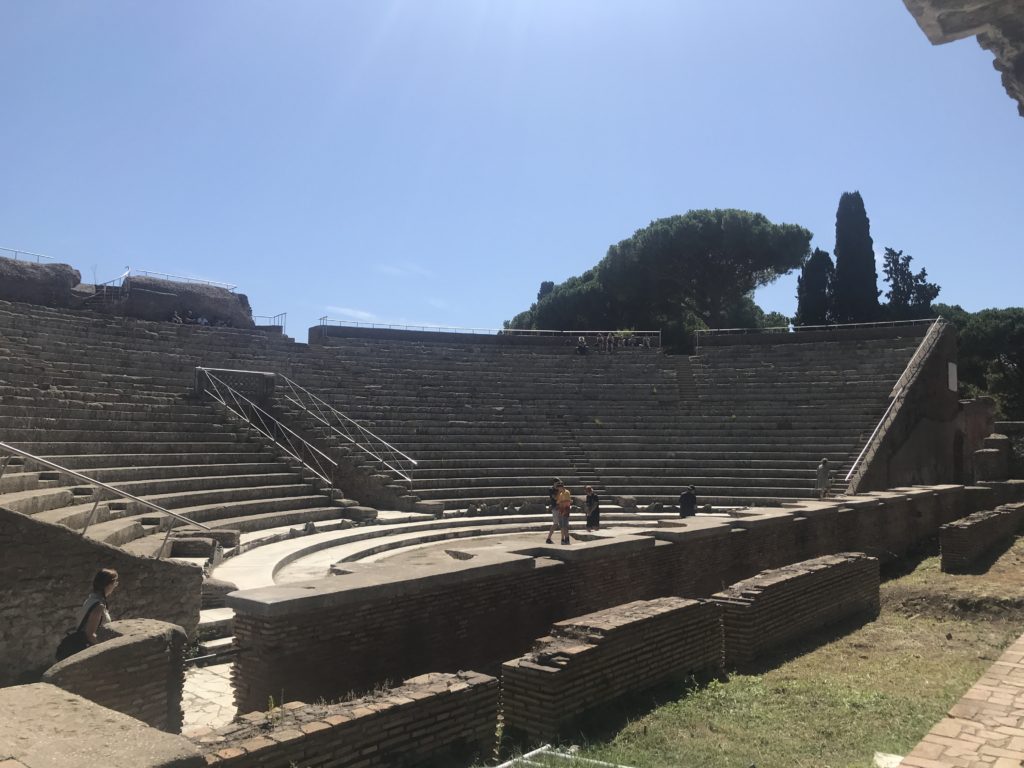
Ostia Antica amphitheatre
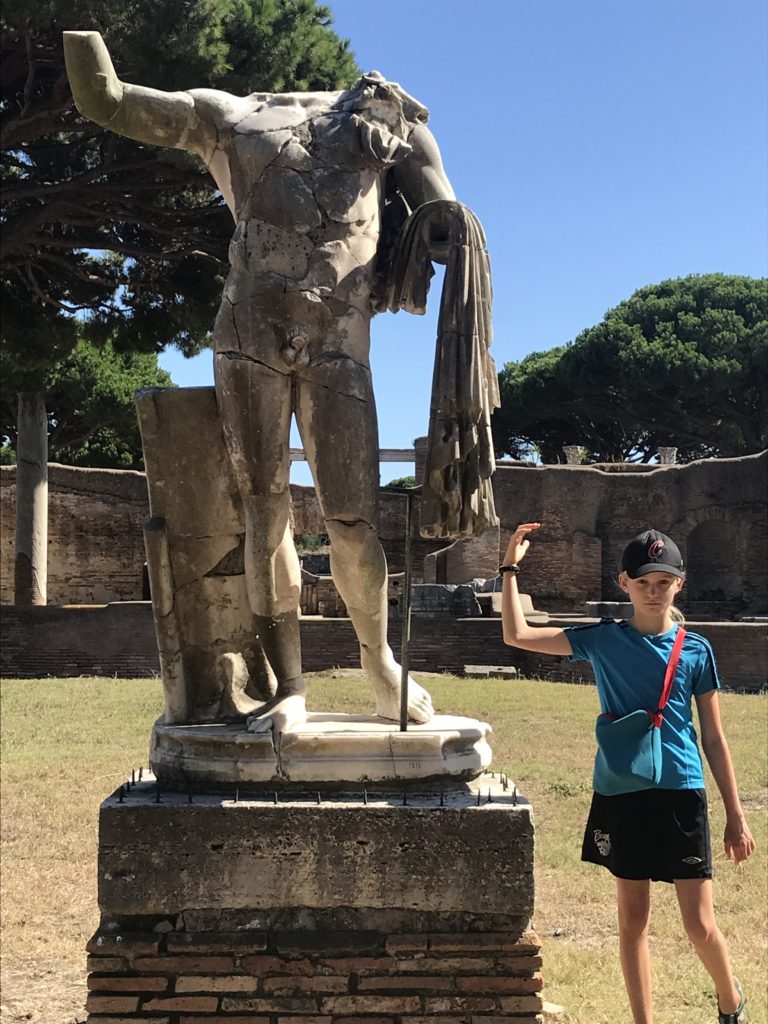
Roman ruins in Ostia Antica
Two more train stops took us to Ostia Lido and then a 10-minute walk to the seaside. We skipped the paid beaches and cooled off in the warm water of the Mediterranean… too tired to linger, but refreshed nonetheless. A perfect day.
The train took us back quickly to the centre of Rome, and then, after showering off the salt of our day in the sun and the sea, we walked not more than 30 seconds to Le Tavernellle, a lively restaurant on the same street as our apartment, for a traditional Roman meal: appetizer, primo, second, dessert. The pasta was amazing. The service lively. And the tiramisu — which had won awards that now hung from the walls — as good as advertised.

Pesto pasta at Le Tavernelle
We would all sleep well tonight











